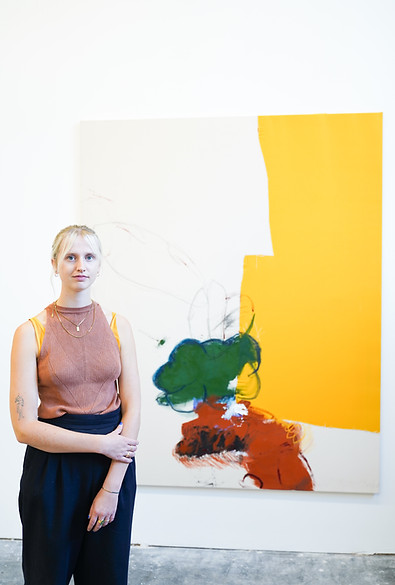
My work is a direct reflection of who I am: my inner world, my emotions, my intuition. When I paint, I let those things guide me. I don’t want to explain my paintings or give them titles, because I want them to stay open and universal. I’d rather create my own visual language, one that allows me to share what can’t be said in words: emotions, meditative atmospheres, the act of painting itself. That’s also why I often leave imprints of my hands and fingers. They are traces of my presence, proof of the movement and energy that shaped the work. For me, the act of painting, the pure craft of it, is both the starting point and the subject that always returns.
Curiosity drives me. I’m constantly exploring materials, their possibilities and limitations, and how they respond to my gestures. I often paint on found fabrics (e.g. old canvases, bed sheets, tablecloths) materials that already carry a history within them. They are never neutral: they hold traces of use, of intimacy, of lives once lived with them. That history resonates with my own memories; it reminds me that painting is always layered, never starting from zero. By painting on fabrics that have already had a place in someone’s life, I connect my inner world with theirs. The work becomes a meeting point between memory and presence, between what was and what is now. Their history becomes both the background and the motif of my painting, an invisible layer that vibrates beneath the surface. This exploration is inseparable from my passion for the process itself: the rhythm, the struggle, the discoveries that happen along the way.
I often push myself by building something up, only to destroy it again. I might paint circles or recognizable forms and then erase them. I like creating friction: drawing organic, abstract shapes on mathematical paper, or letting chance take over. I give the paint space to move by itself, as if the painting wants to paint itself. Working on raw or found fabrics adds to that unpredictability. The fibers absorb the oil, stain the surface, and limit my control. I welcome that resistance; it keeps the work alive and experimental.
Every painting begins with the void: the empty canvas. And in a way, it always returns to it, as the paint seeps back into the linen. What’s left in between is the struggle, the gesture, the silence of painting itself.
Like Per Kirkeby once said: “I am a painter and I painted a painting and really I don’t want to say more about it. A picture is not decided by title or explanation, one has to look at it.”